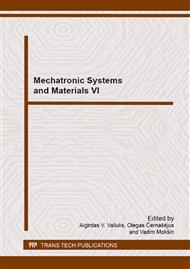[1]
A. Dymarek, Odwrotne zadanie dynamiki tłumionych mechanicznych układów drgających w ujęciu grafów i liczb strukturalnych: Praca Doktorska, Politechnika Śląska, Gliwice, (2000).
Google Scholar
[2]
T. Dzitkowski, Odwrotne zadanie dynamiki dyskretno-ciągłych układów mechanicznych w ujeciu grafów i liczb strukturalnych: Praca Doktorska, Politechnika Śląska, Gliwice, (2001).
Google Scholar
[3]
K. Białas, Passive and active elements in reduction of vibrations of torsional systems, in: Mechatronic Systems and Materials: Mechatronic Systems and Robotics Book series: Solid State Phenomena, 164, 2010, p.260–264.
DOI: 10.4028/www.scientific.net/ssp.164.260
Google Scholar
[4]
A. Buchacz, K. Białas, Odwrotne zadanie dynamiki aktywnych układów mechanicznych w ujęciu grafów i liczb strukturalnych, Wydawnictwo Politechniki Śląskiej, Gliwice, (2005).
Google Scholar
[5]
A. Buchacz, M. Płaczek, Damping of mechanical vibrations using piezoelements, including influence of connection layer's properties on the dynamic characteristic, in: Solid State Phenomena, 147–149, 2009, p.869–875.
DOI: 10.4028/www.scientific.net/ssp.147-149.869
Google Scholar
[6]
A. Buchacz, A. Wróbel, Computer-Aided analysis of piezoelectric plates, in: Mechatronic Systems and Materials: Mechatronic Systems and Robotics, Solid State Phenomena, 164, 2010, p.239–242.
DOI: 10.4028/www.scientific.net/ssp.164.239
Google Scholar
[7]
M. Neubaer, R. Oleskiewicz, K. Popp, T. Krzyżynski, Optimization of damping and absorbing performance of shunted piezo elements utilizing negative capacitance, Journal of Sound and Vibration 298(2) (2006) 84–107.
DOI: 10.1016/j.jsv.2006.04.043
Google Scholar
[8]
A. Buchacz, D. Gałęziowski, Zadanie odwrotne jako projektowanie mechatronicznych układów drgających, Modelowanie Inżynierskie 7 (2009) 19–26.
Google Scholar
[9]
A. Buchacz, D. Gałęziowski, Synthesis and dimensionless transformations of mechatronic vibrating systems, in: Dynamical Systems Analytical/Numerical Methods, Stability, Bifurcation and Chaos, December 5–8, 2011, Łódz, Poland, p.249–254.
Google Scholar
[10]
A. Buchacz, D. Galeziowski, Synthesis as a designing of mechatronic vibrating mixed systems, Journal of Vibroengineering 14(2) (2012) 553–559.
Google Scholar
[11]
K. Jamroziak, Identification of the selected parameters of the model in the process of ballistic impact, Journal of Achievements in Materials and Manufacturing Engineering, International OCOSCO World Press, 49(2) (2011) 305–312.
Google Scholar


